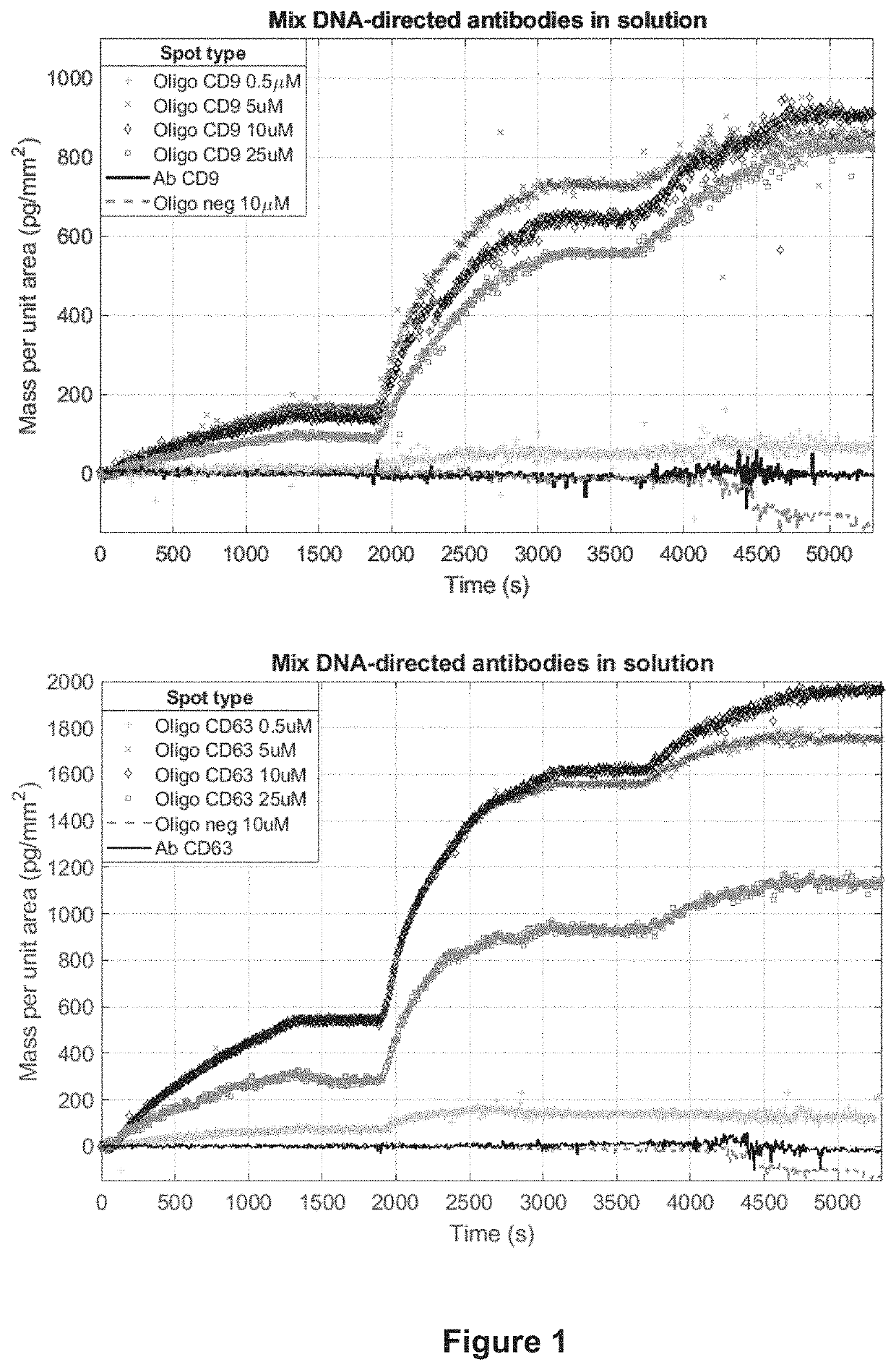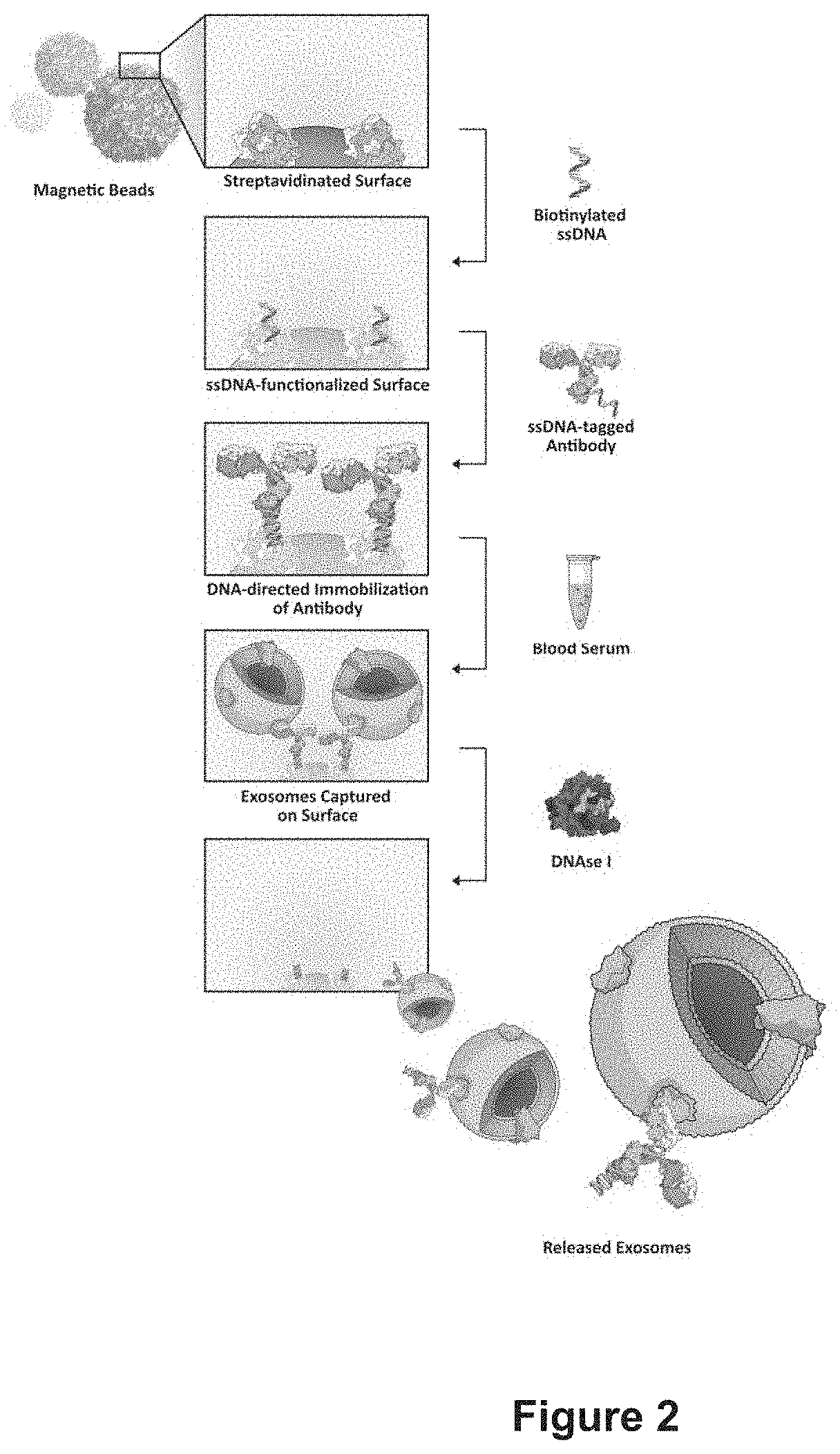Method for the isolation of intact extracellular vesicles
a technology of extracellular vesicles and isolation methods, which is applied in the field of isolation methods of intact extracellular vesicles, can solve the problems of inconvenient high-throughput applications, altering the results of downstream analysis, and method not suitable for harvesting evs from cell culture media, and achieves convenient microarray fluorescence, site-selective surface binding of proteins, and the effect of convenient configuration
- Summary
- Abstract
- Description
- Claims
- Application Information
AI Technical Summary
Benefits of technology
Problems solved by technology
Method used
Image
Examples
example 1
Antibody Functionalization with ssDNA
[0072]Antibodies directed against exosome-specific tetraspanins (CD9 and CD63) were modified with a linker bearing N-oxysuccinimide ester at one end and dibenzocyclooctine (DBCO) at the other end to allow their binding to azido modified oligonucleotides as reported below.
[0073]1.1 Synthesis of ssDNA-AntiCD63: 4.4 μL of a 4 mM PBS solution of DBCO-NHS ester were added to 200 μL of sodium azide-free mouse anti-human CD63 IgG (0.70 mg / ml) and the solution was allowed to react for 30 min at room temperature. The reaction was quenched by adding 20 μL of 1M TRIS-HCl, pH=8.0, and the unreacted ester was removed, through centrifugation over an Amicon Ultra 10K filter (3 min at 12,000×g). The eluted solution was discarded and the protein was recovered in 200 μL of PBS. The oligonucleotide ssDNA-TAG-63 (8.2 μL, 100 μM) was added to 200 μL of DBCO-modified antibody (0.66 mg / ml) and the strain-promoted 1,3-dipolar dycloaddition of cycloalkynes to azide react...
example 2
DNA-Directed Immobilization (DDI) of Antibodies on Silicon Chips
[0075]2.1 Probe spotting on the surface of microarray: both antibody and oligonucleotide solutions were prepared. Amino-modified oligonucleotides complementary to the antibody tag (ssDNA-PROBES) were dissolved at different concentrations (0.5, 5, 10 and 25 μM) in a solution of 150 mM sodium phosphate buffer containing 0.01% sucrose monolaurate at pH 8.5. The probes were then spotted onto the surface of different silicon / silicon oxide chips, depending on the detection technique used. In particular, oxide layers of 110 nm and 55 nm were use for IRIS and SP-IRIS measurements respectively. All chips were coated with copoly (DMA-NAS-MAPS), a polymer commercially available with the trade name of MCP-2 (Lucidant Polymers Inc., Sunnyvale Calif., USA) using a noncontact microarray spotter (sciFLEXARRAYER S12, Scienion, Berlin) equipped with a 80 μm nozzle. MCP-2 is a ter-copolymer of N,N-dymethilacrylamide (DMA) (97% in moles), ...
example 3
Extracellular Vesicle Purification using DNA-Directed Immobilization of AntiCD63 on Magnetic Beads (FIG. 2)
[0082]3.1 Microparticles functionalization: DNA tagged antibodies were immobilized on the surface of magnetic beads and used to immunocapture Evs. Prior to their use, streptavidin-coated magnetic beads (Dynabeads M-270 Streptavidin, Invitrogen) were washed three times with Binding and Washing buffer (B&W) (5 mM Tris-HCl, pH 7,5; 0,5 mM EDTA; 1 M NaCl) according to the manufacturer's protocol. Then 500 i—ig of beads were added to 100 μL of 1μM biotinylated ssDNA-Probe-63 solution. The suspension was stirred for 30 min at 23° C., then the solution was removed and the beads were washed twice with B&W buffer, then once with PBS.
[0083]Oligonucleotide modified beads (500 μg) were incubated with 100 μL of ssDNA-AntiCD63 antibody (160 μg / mL) for 1h at 25° C., then the solution was removed and the beads were washed twice in PBS.
[0084]3.2 Capture and release of EVs from magnetic beads: D...
PUM
| Property | Measurement | Unit |
|---|---|---|
| size | aaaaa | aaaaa |
| size | aaaaa | aaaaa |
| size | aaaaa | aaaaa |
Abstract
Description
Claims
Application Information
 Login to View More
Login to View More - R&D
- Intellectual Property
- Life Sciences
- Materials
- Tech Scout
- Unparalleled Data Quality
- Higher Quality Content
- 60% Fewer Hallucinations
Browse by: Latest US Patents, China's latest patents, Technical Efficacy Thesaurus, Application Domain, Technology Topic, Popular Technical Reports.
© 2025 PatSnap. All rights reserved.Legal|Privacy policy|Modern Slavery Act Transparency Statement|Sitemap|About US| Contact US: help@patsnap.com



